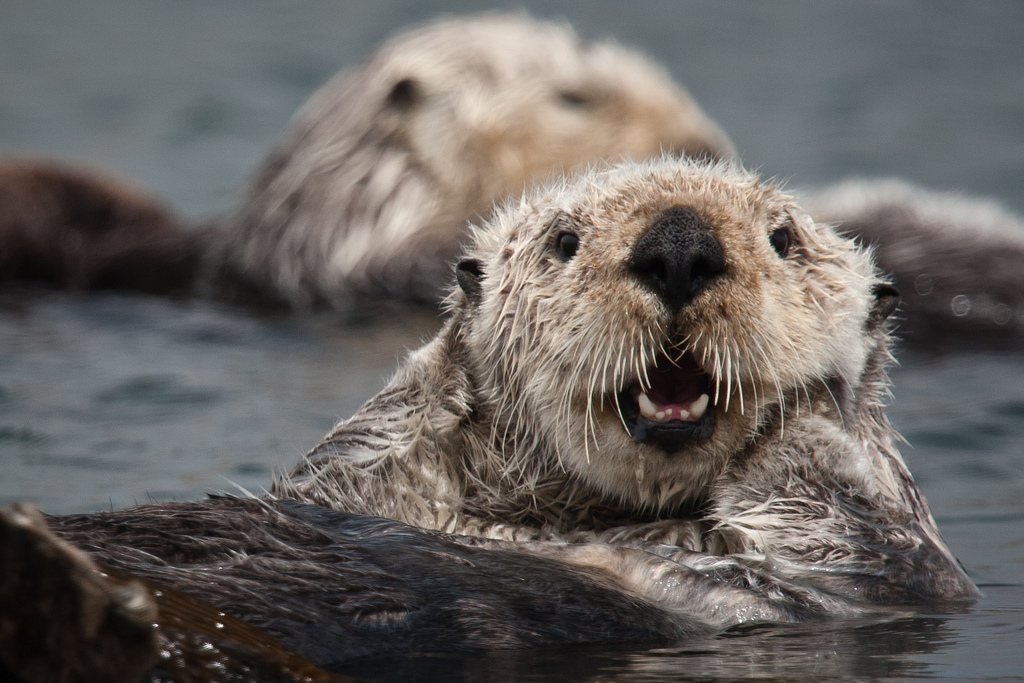
mike baird“Would you look at this mess? No, no — I got it. This time.”
Turns out sea otters do much more than just explain discount rates with aplomb: The adorable little buggers also clean up our oceanic messes. Nitrogen and phosphorous runoff from agricultural pollution creates algal blooms that choke the life out of estuaries — unless these thoughtful, fuzzy Dysons are around. With sea otter populations expanding into California habitats like Elkhorn Slough, where they haven’t been seen for 100 years or more, scientists are watching sea grass and kelp ecosystems return, even though humans are still proverbially shitting the proverbial waterbed. Sci-blogger-genius Ed Yong has more:
Sea otters grab shellfish and other prey from the sea floor and smash them open on the surface, using rocks as hammers and their own bellies as anvils. This makes it very easy for scientists to record what they’re eating, and Hughes used decades of such records to show that the Eklhorn sea otters are crab-specialists. “We estimate that they can easily remove 400,000 crabs per year in an area the size of 7 football fields,” he says. “That’s a huge effect, which cascades down to affect the seagrass.”
The crabs eat other animals including an orange sea slug and a shrimp-like isopod, both of which graze on algae. So by killing the crabs, the otters inadvertently protect the slugs and isopods, which in turn protect the seagrass by nibbling away at encroaching algae. This complicated four-part chain reaction (or “trophic cascade”) is what keeps Elkhorn Slough in its current healthy state.
To make sure the otters were responsible, researchers ran otter simulations — which sadly did not include grad students in discount otter suits bought from the local Furry-in-a-Hurry outlet. Ahem:
His team ringed off small areas of estuary and added fixed amounts of seagrass, slugs and isopods. Then, they added either the small crabs you find when sea otters are around, or the large ones you get when the otters are absent. The bigger crabs did indeed eat more grazers, leading to more algae and less seagrass.
Sea otters are near the top of their food chain, and it’s not surprising that they exert a strong top-down influence upon other local animals. In iconic studies during the 1970s, James Estes established them as classic examples of keystone species — those that are disproportionately influential for their numbers. They protect kelp forests by eating the sea urchins that would otherwise raze them down. With otters, you get underwater jungles of wavy green kelp. Without the otters, you get bare “urchin barrens”.
“The really interesting discovery here is that otters counter the detrimental impact of eutrophication,” says Estes. In other words, their top-down influence is strong enough to nullify the bottom-up effects of nutrients entering the slough.
As sea otter populations expand into their historic range, their tidy aftershocks could help rehabilitate ecosystems all the way to Baja California. If this also means I can get to Mexico by hugging one ultra-plush otter belly after another instead of waiting behind grinding I-5 traffic, I fully support redirecting the entire federal budget to an emergency militarized otter reintroduction plan. (What? It just makes fiscal sense, people.)
Aww, you adorable sea otters — you shouldn’t have. (Wait, no, you should!)



